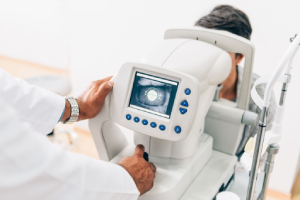Glaucoma
Glaucoma
Glaucoma can be of the following types:
Primary glaucoma
Primary open-angle glaucoma: The drainage canals in the eye are slowly clogged due to which intraocular pressure increases, leading to a progressive damage in optic nerve. It starts off as peripheral vision’s loss. Gradually the affected person’s vision will be lost in primary open-angle glaucoma if it is not treated.
Primary angle closure glaucoma: The iris and trabecular meshwork come into contact with each other causing a blockage in the way of aqueous humor flowing out of the eye. The draining ability of the meshwork degrades due to the contact between the iris and trabecular meshwork. The intraocular pressure rises. The disease suddenly onsets and leads to development of pain and other symptoms.
Developmental glaucoma: It is a type of glaucoma that occurs in babies, young children and teenagers. It lead to harm to the optic nerve of the eye due to increased intraocular pressure. Primary congenital glaucoma, infantile glaucoma and glaucoma associated with hereditary or familial conditions are contained within developmental glaucoma.
Secondary glaucoma: Increased intraocular pressure is caused due to drug, trauma or procedure, leading to damage in optic nerve and vision loss. Its treatment is dependent on whether it an open-angle or angle-closure glaucoma.
How is glaucoma treated?
Glaucoma can be treated with the help of medication and/or surgery. Intraocular pressure can be lowered with the help of medium, usually in the form of eye drops. Both type of surgeries, conventional and laser, can be used to treat glaucoma. They do not offer a permanent solution though, as glaucoma has no cure. But it can be managed and treated to a large extent. Some of the surgeries done to treat glaucoma are as follows:
Canaloplasty: An incision is made into the eye through which a microcatheter is inserted that increases the size of the main drainage channel and its collector channels. Microcatheter is taken out of the eye and a suture is done within the canal.
Trabeculectomy: A flap of partial thickness is created in the wall of the sclera, along with an opening below the flap to take out a part of trabecular meshwork. A suture is placed on to the flap of sclera to let the fluid start to flow out of the eye. This results in a lower intraocular pressure.
Laser assisted nonpenetrating deep sclerectomy: Using a CO2 based laser system, glaucoma can be treated. The system shuts down on its own once the scleral thickness needed and proper drainage of intraocular fluid has been achieved.
Why Vedanta Jyoti Eye Hospital?
Our Glaucoma department offers early diagnosis and treatment modalities for Glaucoma. All types of diagnostic and treatment options are available to detect, treat and control glaucoma.






